After a brief delay, Mass Effect Paragon Lost will indeed launch to the gaming populous. While many in the Mass Effect community are giving the anime a lukewarm reception, some will no doubt love the inclusion of any new Mass Effect content.
-
VPC: $8.35 ▲Value Per Click
-
VPCO: $0.00 ▲Value Per Comment
-
VPL: $0.00 ▼Value Per Like
-
VPM: $0.00 ▲Value Per 1k Impressions
-
VPS: $0.00 ▼Value Per Share
-
VPV: $0.00 ▲Value Per View
-
VPCO: $7.71 ▲Value Per Comment
-
VPL: $0.00 ▲Value Per Like
-
VPM: $0.00 ▼Value Per 1k Impressions
-
VPV: $0.00 ▲Value Per View
-
VPC: $2.86 ▲Value Per Click
-
VPCO: $0.00 ▼Value Per Comment
-
VPFAV: $0.00 ▼Value Per Favorite
-
VPL: $0.00 ▼Value Per Like
-
VPM: $0.00 ▼Value Per 1k Impressions
-
VPR: $0.00 ▼Value Per Reply
-
VPS: $4.08 ▲Value Per Share
-
VPV: $0.00 ▲Value Per View
-
VPC: $20.79 ▲Value Per Click
-
VPCO: $0.00 ▼Value Per Comment
-
VPL: $0.00 ▲Value Per Like
-
VPM: $0.00 ▲Value Per 1k Impressions
-
VPS: $0.00 ▲Value Per Share
-
VPV: $0.00 ▲Value Per View
Mario Warfare — Parts 1 and 2
Mario Warfare is from the creators of the acclaimed Modern War Gear Solid parody series. There’s some entertaining gunplay in here along with a good amount of parody – bet you never knew Toad was such a badass!
Instagram’s Christmas Exodus
Instagram lost about a quarter of daily active users since it tried to implement new terms of service last month, according to AppData. The photo-sharing site is disputing the claim.
In an article that first appeared in the New York Post, AppData released figures that showed Instagram usage peaking at approximately 16.4 million users in mid-December but falling to 12.4 million the week of Christmas.
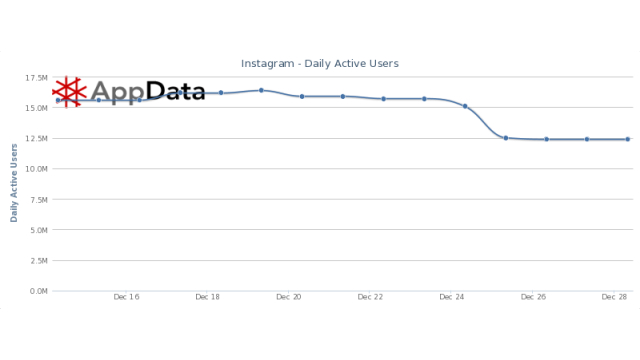
“[We are] pretty sure the decline in Instagram users was due to the terms of service announcement,” AppData told the Post.
Instagram responded with a brief statement circulated to news outlets, stating, “This data is inaccurate. We continue to see strong and steady growth in both registered and active users of Instagram.”
Other data providers and some tech sites have since come to Instagram’s defense, with counter claims ranging from holiday traffic dips to outright bad data, and at least one label of “sensationalism” for the Post’s piece.
On December 17, Instagram released new terms of service designed to make it a more ad-friendly platform. Users perceived the changes as losing ownership of their content to the point where the Facebook-owned photo sharing site could use their uploaded photos in advertising without consent. The backlash was immediate and widespread. One power user in particular — Kim Kardashian who has 5.8 million followers — announced she would no longer be using the service. Instagram quickly backtracked, reverting the advertising section of its terms back to the original version. (It’s worth noting Kardashian is still not using the site.)
Time will tell on any tangible effect from Instagram’s very Facebook-like snafu in announcing a change in service terms. For now, the bad publicity is a very real stain.
Source: VentureBeat.com
Blast Some Goons
Gangster Squad: Tough Justice is an online action RTS that transports you to the golden-era Hollywood in the grip of an all-out war between mobsters and police. Based on the upcoming movie, Gangster Squad, starring Emma Stone, Ryan Gosling and Sean Penn. Get ready to battle mobster Mickey Cohen’s goons and upgrade your skills and loot crates for more firepower, but keep on your toes or you’ll be sleeping with the fishes.

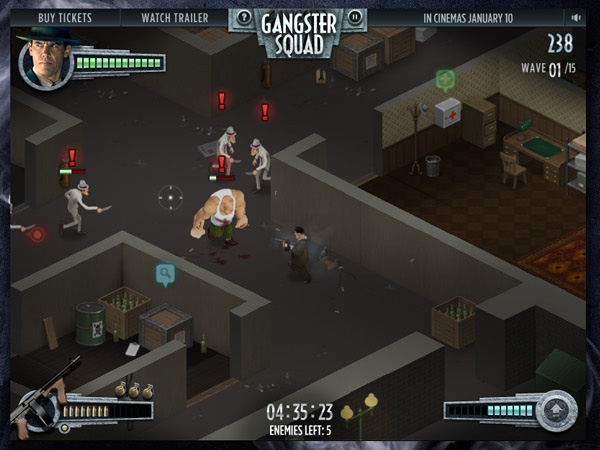
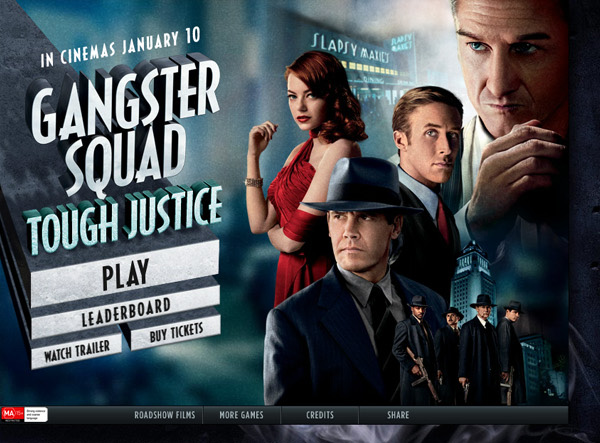
And is really good fun, although we were unspeakably s*** at it, if we’re being honest. But that’s par for the course with us. We’re still trying to complete Sonic The Hedgehog. See if you can do better and show ’em who’s boss here ToughJustice.com.
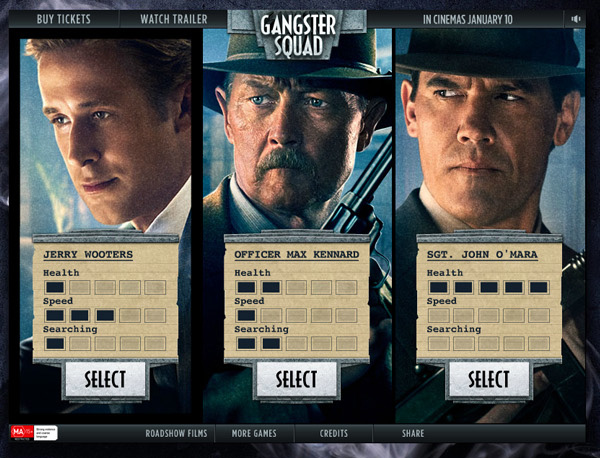
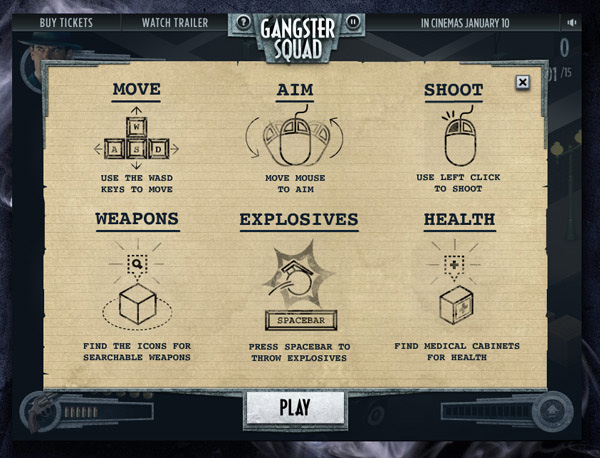

Elite: Dangerous Hits Kickstarter Goal
The Elite: Dangerous Kickstarter campaign has hit its £1,250,000 goal from over 22,000 backers. Frontier and its head David Braben indicate that the cult space simulator series will see a new release in March 2014.
“We have announced a stretch goal for a Mac version of the game. If we reach the stretch goal of £1.4 million through the Kickstarter we will release a Mac version approximately 3 months after the Windows PC release,” noted Frontier. “New stretch goal announced, if we reach £1.5 million then we’ll add another 10 playable ships to the game.”
Source: Kickstarter.com
iOS 7, Next iPhone Indicators Appear
Reports are that there are traces of Apple’s new iPhone and iOS software surfacing in app usage logs. It is believed that the next operating system will be iOS 7, though it is unknown exactly what form the next iPhone will take.

“One developer showed us that Apple has been testing hardware relating to a new ‘iPhone6,1’² identifier, powered by a device running iOS 7, which is expected to be released by Apple in the middle part of this year,” writes The Next Web. “Apple’s current flagship, the iPhone 5, bears the identifiers ‘iPhone5,1’² and ‘iPhone 5,2’² depending on the LTE model of the handset and the 4G bands on which it operates.”
Source: TheNextWeb.com
App Downloads Over 2012 Holidays Reach New Highs
Flurry says that 50 million Android and iOS devices were activated between December 25 and January 1. A full 17.4 million devices were activated on Christmas Day alone, compared to just 6.8 million activations last year.
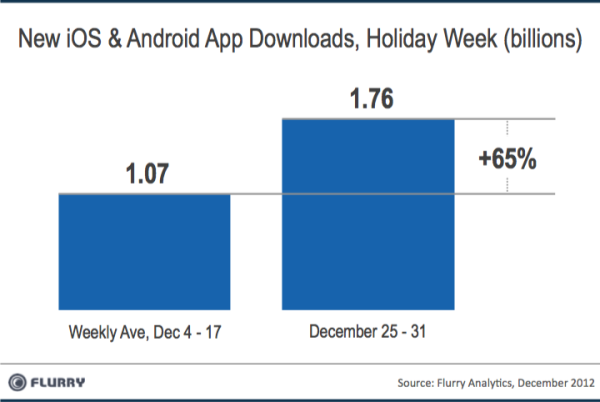
There were 328 million app downloads on Christmas Day and 1.76 billion by the end of the period. The U.S. led the world with 604 million downloads, China was second with 183 million downloads (despite not celebrating Christmas), and the UK trailed in third with 132 million.
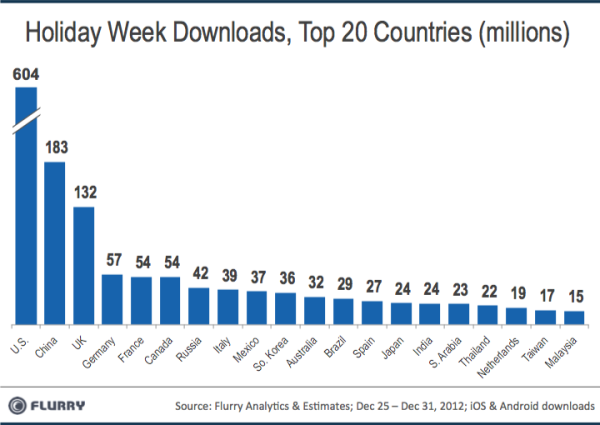
“Looking forward to 2013, Flurry expects the trend of one-billion-download weeks to become the norm, and that the industry will surpass the two-billion download week during Q4. Following a year where Google and Apple drove unprecedented adoption of mobile devices, Facebook declared itself a ‘mobile’ company, and Amazon and Microsoft both made significant investments into mobile computing, we look forward to continued record-breaking adoption of smart devices and applications,” writes Peter Farago of Flurry.
Source: Blog.Flurry.com
Mario Warfare Hits Kickstarter Goal
Beat Down Boogie’s Kickstarter for Mario Warfare has exceeded their $20,000 goal. With this done, the production company confirms that it will be using extra funds to make Mario Warfare “MORE epic.”

“If we raise 40,000 we’ll dress up Matt Sumner (our lead actor) as Sailor Moon and make a film about it,” they stated of their stretch goals. “If we raise 50,000 we’ll make a new episode of Modern War Gear Solid. If we raise A RIDICULOUS AMOUNT we can make Beat Down Boogie a full-time thing, and create a lot more content each year.”
Source: Kickstarter.com
Metacritic Sees Low Level Of Top Reviewed Titles In 2012
According to Metacritic, only 14 console games (18 products overall) scored 90 or higher in 2012. By contrast, last year 23 console titles (and 32 games overall) hit or exceeded the 90 mark, giving 2012 the lowest total of good games since the site began its end of year report in 2009.

“We also expect some grumbling about our Game of the Year award, given annually to the year’s overall highest-scoring (i.e., best-reviewed) game for any platform,” says Jason Dietz, Metacritic features editor. “This year’s honoree, Telltale’s The Walking Dead 95 (Xbox 360), is a terrific adaptation of Robert Kirkman’s comic books. But it is also a retail repackaging (with a mere 9 reviews, at press time) of a game that was previously released online in five episodic installments throughout the years’ installments which, though well-reviewed, never achieved an individual score north of 89. (There’s also the issue of the retail version’s reported buginess.) Still, without a solid reason to exclude it from consideration, its score qualifies it for Metacritic Game of the Year honors, even if it is the lowest-scoring such game since 2003 (when the PC version of Grand Theft Auto: Vice City topped the high score chart with a 94).”
The PS3 had the Metacritic average, but it had fewer good and great games than the Xbox 360 and the Wii U had fewer still.
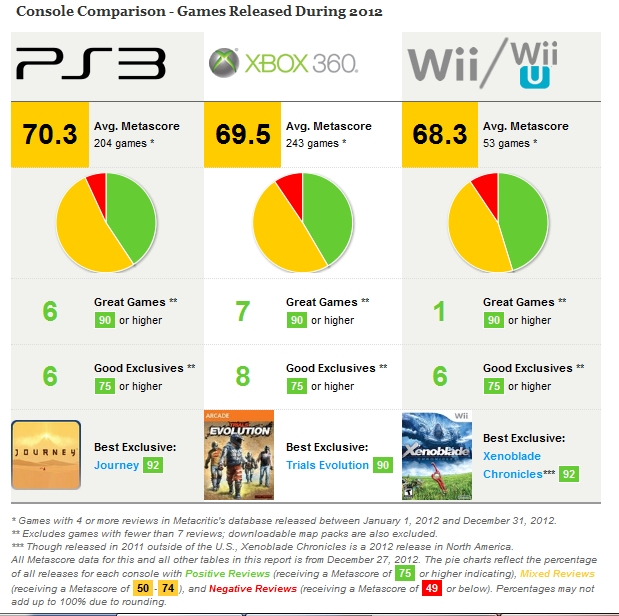
“The average Metascore for all 360 releases in 2012 was up a full point compared to the previous year, though the percentage of all Xbox games receiving positive reviews dropped this year from 43 percent to 41.6 percent. Still, there were 101 Xbox games receiving positive reviews this past year, which was the highest total for any console by a wide margin,” writes Dietz. “There were also fewer notable exclusive games on Microsoft’s platform to differentiate it from other consoles. For the second straight year, just two of the 15 highest-scoring 360 titles were exclusive to the console. And the number of positively reviewed Xbox exclusives dropped from 12 in 2011 to just 8 this past year.”
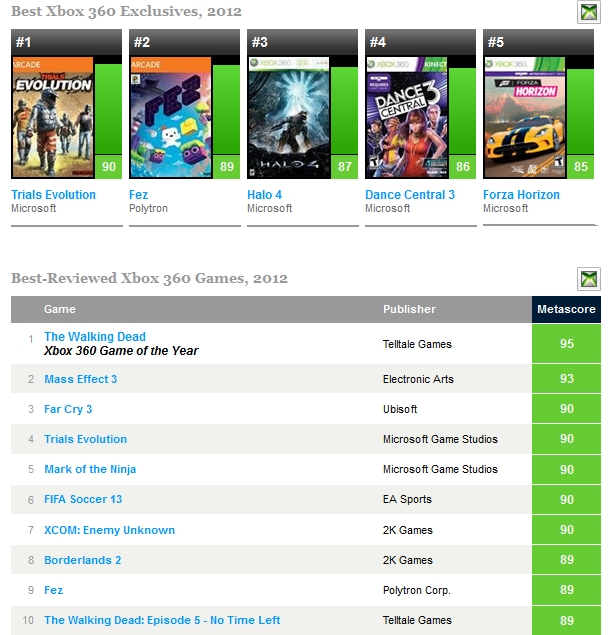
“40.7 percent of PS3 releases in 2012 received positive reviews (scoring 75 or higher), an improvement compared to the previous year’s 38 percent success rate (though still not quite high enough to beat the Xbox’s percentage). Another improvement: fewer than 7 percent of all PS3 releases in 2012 received negative reviews (scores of 49 or lower) from critics, a figure that bests last year’s mark of 8 percent as well as leading all consoles this year,” notes Dietz. “Like the Xbox high scores list, the ranking of 2012’s best PS3 games was dominated by cross-platform releases. In fact, only one PS3 exclusive — the wholly unique Journey, from the creators of Flow and Flower — cracked the console’s top 25. (Note that we don’t count HD remasters of older titles, such as Okami HD or the Ratchet & Clank Collection, as “exclusive” to the PS3.)”
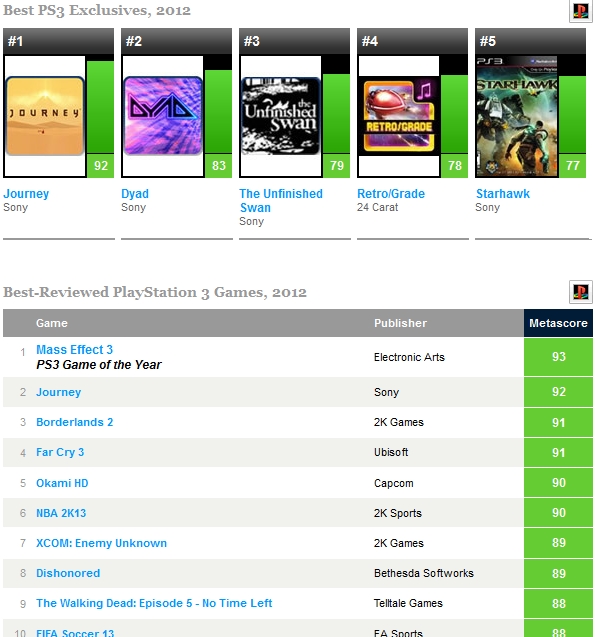
“This was obviously a transition year for Nintendo console gaming. With the new Wii U scheduled to arrive in stores toward the end of 2012, few publishers were still releasing games for the older Wii platform this year. And while the Wii U arrived with a few dozen titles in tow, many of the console’s first major games — including some that Nintendo is still defining as “launch” games — will not surface until 2013. The result is a very short list of positively reviewed new titles for Wii owners, and a lack of buzz-generating games like a Zelda or a Metroid,” adds Dietz. “Note also that this year’s best-reviewed Wii exclusive also comes with an asterisk. Xenoblade Chronicles, the top-scoring Wii or Wii U title by a large margin, was actually released in Japan two years ago and in much of the rest of the world in 2011, before finally landing in North America in early 2012. Because, for consistency, we use U.S. release dates throughout Metacritic (unless there is no American release), Xenoblade is classified as a 2012 release, and thus takes the Wii crown for the year.”
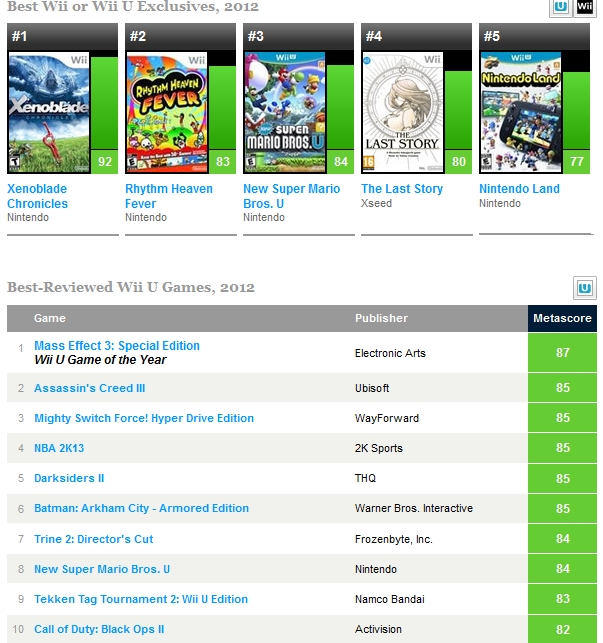
Incentives, Choice Get The Most Out Of Mobile Ads
By Meelad Sadat
More than two thirds of mobile users find in-app ads intrusive, and nearly half of them completely ignore what they see. But engagement can improve when ads offer incentives or let users choose which ones to watch. These are among top takeaways from a recent Forrester study commissioned by Tapjoy that surveyed 2,000 smartphone owners in the US.
Apps now dominate mobile device use. According to the study, “The Mobile In-App Marketing Opportunity,” people dedicate more than 81 percent of their time on smartphones to app usage versus less than 19 percent for browsing the internet. They own a lot of apps – 29 percent own 21 or more, and 20 percent say they download new ones every day. Three quarters use them on a daily basis, with social networking, playing games and music apps topping usage. Few are paying however. More than a third have stuck to strictly free apps, and another third said they’ve paid for less than 25 percent what they own. In a separate study, Forrester says it found a third of US adults who use mobile apps on a monthly basis prefer free ad-based apps over paying for them.
Not surprisingly, that fondness is for the ‘free’ and not so much the ‘ad-based’ part. This most recent study shows perception of these ads running the gamut from “interruptive” and annoying to just plain easy to ignore. Of those surveyed, an astounding 86 percent said they find what they see as irrelevant.
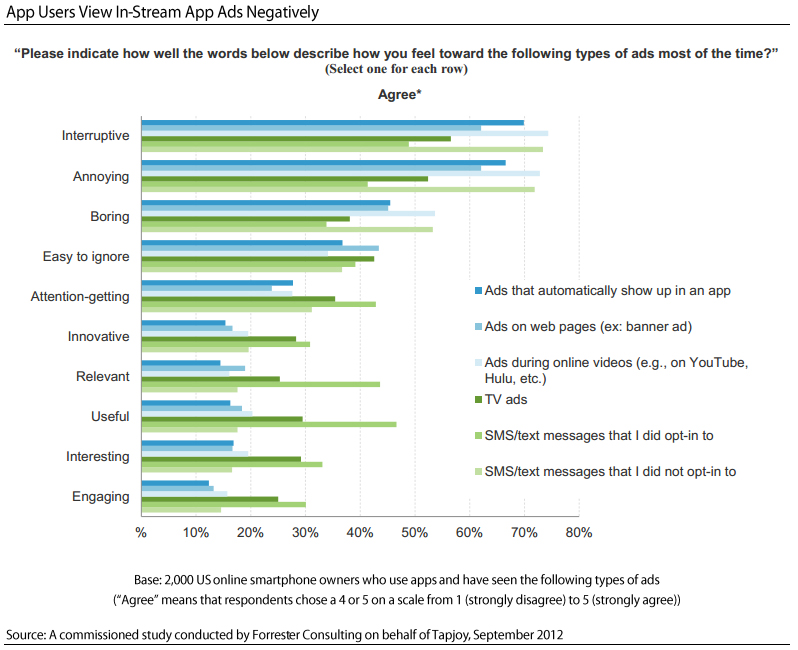
That’s where Tapjoy’s role in commissioning the research comes in. The company’s mobile app monetization and advertising platform is incorporated into more than 20,000 apps worldwide. Among its offerings is a new service that delivers ads where users can opt-in to which kind of product they want to be marketed, and also gives incentives for engaging with the ads they choose. Tapjoy’s Forrester study shows this is what users want – 68 percent agreed that marketers need to minimize how ads interrupt their experience, and 59 percent want some sort of reward or incentive for clicking on an ad.
Tapjoy says the study shows these methods can help leverage mobile’s audience captivity, using its intimacy and immediacy to deliver a better experience and prompt higher engagement. We talked with Tapjoy chief marketer Peter Dille on what the study’s findings mean for mobile marketers and app makers.
What prompted Tapjoy to commission this study?
There’s a lot of confusion about what works — and what doesn’t — in mobile advertising today. We’ve long believed that an opt-in, incentivized advertising model works. That said, incentivized advertising still has a stigma among some advertisers that it doesn’t attract the best users, and that it’s not a serious option for major brands. This came about mostly because of the first wave of “incentivized advertising” that took place on the Web nearly a decade ago, where people were being rewarded with offers of free iPods and the like. This new generation of opt-in, incentivized ads could not be further removed from that type of advertising, but that initial backlash still causes advertisers to pause before putting their feet in the water. We commissioned this study from Forrester to show that not only do consumers want this type of advertising model, but the tactics of Web advertising aren’t best for mobile, either.
Users are showing preference for free apps with ads over paid apps. Are the stakeholders — app creators and advertisers — seeing enough returns or even the potential for returns to believe that this is a sustainable economic model?
For developers, many of the top-grossing apps in both the Apple App Store and Google Play are free-to-play. We recently worked with Madfinger Games, creators of Dead Trigger (one of the most popular games on mobile at the moment) and, by using a free-to-play model and integrating with Tapjoy, helped them increase their revenue by 66 percent on Android and 48 percent on iOS. Smule, creators of Magic Piano (also free-to-play), was able to double their revenue thanks to a special currency promotion we hosted for them. These are just two of the thousands of examples of successful free-to-play apps across our network. We are major advocates of the free-to-play model for apps and strongly believe it’s the best way for developers to monetize their apps on mobile. For advertisers, we enlist more and more major brands every day, a clear sign to us that even the major players are seeing the need to shift their media mix to properly address mobile.
The study says people hate interruptive in-app ads, and at the same time half of people surveyed said they ignored the last one they saw. For those who noticed ads, sentiment and engagement metrics are low. Where are advertisers getting it wrong?
First, many advertisers are missing an opportunity with opt-in models. Consumers responded strongly about having more control over their advertising experience in their mobile apps. In the survey, almost 40 percent of the respondents said they would be interested in picking the most relevant option from a list of advertisements. Advertisers also need to improve their targeting on mobile, and make their advertisements more relevant to their target audience. Almost half of the respondents to the survey said they want ads relevant to their personal interest and their location. Only 14 percent of consumers are getting that type of experience on mobile right now, which means advertisers need to improve their targeting techniques.
Can you give us any examples of mobile ads, whether in-app or not, that proved highly effective?
We have many types of ads that have delivered superior results for our brand partners compared to both their Web campaigns and other types of mobile ad campaigns. In once recent campaign, for instance, our Cost-Per-Completed-View video ads drove higher ad awareness, brand favorability and purchase intent compared to mobile norms. In fact we will soon be publishing a case study demonstrating this difference, and we will be glad to share it with you once it’s available.
One big takeaway from the study seems to be pull marketing beats push on mobile. Besides delivery methods like giving people a choice of which ad to watch, what do you see here for marketers to take into consideration in the content they create?
According to the Forrester study, consumers want more control over their mobile advertising experience. With even a quick glance at the survey results, it’s clear that the current state of mobile advertising isn’t delivering an experience that customers want or enjoy. Just 17 percent of respondents found current in-app ads interesting, and 70 percent said they found automatically served in-app ads interruptive. However, when consumers have a chance to opt-in to an advertising experience and can earn a virtual reward for their engagement, consumers showed an increase in receptivity. It’s also apparent from the Forrester study that consumers understand the virtual economy, and are willing to engage with their favorite brands in exchange for the content they want, especially when they choose the brand to interact with.
It’s ancillary to the study, but I’d love to get your thoughts on this set of findings: Here is a study on mobile ads that finds online ads — video and banners — perceived to be the least effective, and TV ads still considered very effective. As a marketer talking to your colleagues, how would you couch this?
TV still provides excellent reach for an advertiser, to a scale that neither the web nor mobile can achieve at this point. That said, advertisers can never be certain how many of the potential eyeballs a TV ad truly reaches.
Any final thoughts?
While we commissioned the study, you can’t buy Forrester’s opinion, so we are obviously excited about the results. The results provide strong affirmation for the consumer dynamics that we’ve long observed through our model. Since mobile is still evolving, we always encourage advertisers to try different solutions to find what works best for them. Additionally, it’s also helpful to enlist a reputable team like Forrester to help sift through the new solutions that are routinely introduced to the space.
